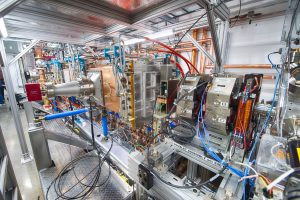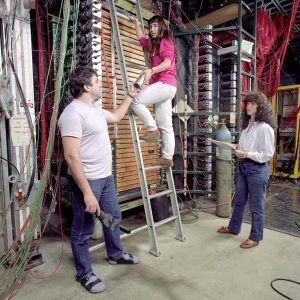What could be better than spending a fun-filled day outdoors and learning about natural science at the same time?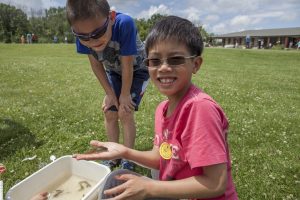
For the ninth year in a row, Fermi National Accelerator Laboratory is inviting families, scout troops and other youth groups to attend the Family Outdoor Fair on Sunday, June 12, from 1-4 p.m. The fair takes place outside the Lederman Science Center and highlights the plant and animal life found on the 6,800-acre Fermilab site in Batavia.
More than a dozen outdoor activities are planned for the fair, including a prairie scavenger hunt and a visit with Fermilab’s herd of bison. Kids can test whether they can run as fast as a bison, can sweep for insects and other critters, and thanks to the Naperville Astronomical Association, safely get a long look at the sun.
Once again, the Northern Illinois Raptor Rehabilitation and Education Center, along with local raptor trainers, will be on hand with live hawks, falcons and owls, as well as a collection of bird bones, feathers and hunting gear for children to enjoy.
“We want kids to come away with an appreciation of nature,” said Sue Sheehan of the Fermilab Education Office. “There’s so much to see. We want to show kids and parents that science is everywhere, even in their own back yards.”
Of course, their back yards aren’t quite as vast as Fermilab’s. More than 1,000 acres of the laboratory site is restored natural prairie, and the U.S. Department of Energy has designated Fermilab a National Environmental Research Park.
The Family Outdoor Fair is geared for first through seventh grade students. The fair is free and will take place rain or shine. Members of the media are welcome to attend. No registration is required. For more information, call 630-840-5588 or email edreg@fnal.gov.
Fermilab is America’s premier national laboratory for particle physics and accelerator research. A U.S. Department of Energy Office of Science laboratory, Fermilab is located near Chicago, Illinois, and operated under contract by the Fermi Research Alliance, LLC. Visit Fermilab’s website at www.fnal.gov and follow us on Twitter at @Fermilab.
The DOE Office of Science is the single largest supporter of basic research in the physical sciences in the United States and is working to address some of the most pressing challenges of our time. For more information, please visit science.energy.gov.
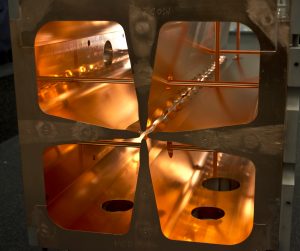
This photo of the RFQ for the Fermilab PIP-II accelerator was taken during the assembly phase at Lawrence Berkeley National Laboratory. Photo courtesy of Andrew Lambert, Berkeley Lab
In March, the Fermilab Accelerator Division successfully sent beam through a newly commissioned linear accelerator. The brand new radio-frequency quadrupole (RFQ) linac, designed and built by a team of engineers and physicists at Lawrence Berkeley National Laboratory, will be the start for a proposed upgrade to Fermilab’s 800-MeV superconducting linear accelerator.
“The RFQ is one of the biggest challenges faced by our group,” said Derun Li, lead scientist on the RFQ development team and deputy head of the Center for Beam Physics at Berkeley Lab. “And seeing it take nearly 100 percent of the source beam on its first try is great!”
The new, front-end accelerator is one of several upgrade projects conducted under PIP-II, a plan to overhaul the Fermilab accelerator complex to produce high-intensity proton beams for the lab’s multiple experiments. PIP-II is supported by the DOE Office of Science.
Currently located at the Cryomodule Test Facility, approximately 1.5 miles northeast of Wilson Hall, the RFQ took first beam – 100-microsecond pulses at 10 hertz – during its first testing phase. Since its first run in March, the team has been working on various commissioning activities, including running the pulsed beam through the RFQ and its transport lines. These activities are expected to continue until June.
The goal of these tests is to provide intense, focused beams to the entire accelerator complex. The lab’s current RFQ, which sits at the beginning of the laboratory’s accelerator chain, accelerates a negative hydrogen ion beam to 0.75 million electronvolts, or MeV. The new RFQ, which is longer, accelerates a beam to 2.1 MeV, nearly three times the energy. Transported beam current, and therefore power, is the key improvement with the new RFQ. The current RFQ delivers 54-watt beam power; the new RFQ delivers beam at 21 kilowatts – an increase by a factor of nearly 400.
RFQs are widely used for accelerating low-energy ion beams, and the energy of the beams they produce typically caps off at about 5 MeV, said Paul Derwent, PIP-II Department head. These low energy protons will then undergo further acceleration by other components of Fermi’s accelerator complex, some to 8 GeV and others to 120 GeV.
The new RFQ is 4.5 meters long and made of four parallel copper vanes, as opposed to four rods used on the current RFQ. As viewed from one end, the vanes form a symmetrical cross. At the center of the cross is a tiny aperture, or tunnel through which the beam travels.
If you were to remove one vane and peer inside the RFQ from the side, you would see an intricate pattern of peaks and valleys, similar to a waveform, along the inner edge of each vane. Like puzzle pieces, the vanes fit together to form the small tunnel with the rippling walls of that inner waveform shape. The farther down the tunnel you go, and therefore the higher the beam energy, the longer the spacing of the peaks and valleys. This means that the time the beam needs to go from peak to valley and back remains constant, necessary for proper acceleration.
Jim Steimel, the electrical engineering coordinator for PIP-II and a Fermilab liaison for Berkeley’s RFQ development team, said this shape is a special trait in RFQs; one that creates an electromagnetic quadrupole field that focuses low-velocity particles.
“As the beam travels through the RFQ tunnel, longitudinal electrical fields generated by the vane peaks and valleys accelerate particle energy,” Steimel said. “This helps focus the beam and keeps the particles accelerating.”
The Berkeley team successfully designed the accelerator to bring beams to a higher intensity than Fermilab’s previous RFQ technology could achieve – energy that matches PIP-II’s front-end requirements.
“Our challenge was to come up with a design that uses minimum radio-frequency power and delivers the required beam quality and intensity, and to engineer a mechanical design that can withstand continuous operation at high average power,” Li said.
Li’s team took into account potential problems that may occur at a power of 100 kilowatts or more, which was needed to maintain the electromagnetic quadrupole field inside the RFQ.
For example, at higher powers temperatures can rapidly increase, causing thermal stress on the RFQ components. Large water flow rates and durable materials are needed to withstand heat and prevent deformations, which is a significant mechanical engineering feat.
“The Berkeley team is proud to have been a key contributor to the first phase of the PIP-II upgrade,” said Wim Leemans, director of Berkeley Lab’s Accelerator Technology and Applied Physics Division. “Berkeley physicists and engineers have been building RFQs for a number of users and purposes for 30 years, and this is a great example of getting the most leverage out of the agency investment.”
Now that the Berkeley and Fermilab teams demonstrated that the RFQ can generate intense beams in pulses, the next step will be to create a continuous high-intensity beam for PIP-II. The team expects to achieve a continuous beam in the summer.
“Fermilab and Berkeley have a long history of collaboration,” Derwent said. “This was just another one where it has worked very well, and their expertise helped us achieve one of our goals.”
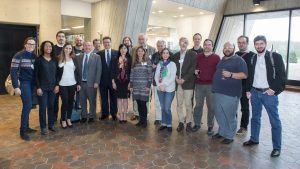
Consul General of Brazil Paulo Camargo (eighth from left) recently visited Fermilab, as did Janaina Solomos (fourth from left), also from the Brazilian consulate. Two directors of Brazilian national labs also visited Fermilab: Brazilian Center for Physics Research Director Ronald Shellard (11th from left) and National Observatory Director Joao dos Anjos (13th from left). Fermilab Director Nigel Lockyer is 6th from the left. Brazilian scientists at Fermilab include Marcelle Soares-Santos (second from left), Fernanda Garcia (12th from left) and Carlos Escobar (sixth from right). Scientists at Brazilian institutions include Mateus Carneiro of the Brazilian Center for Physics Research (3rd from left) and Ernesto Kemp of the State University of Campinas (fourth from right). Photo: Reidar Hahn
“Wish you were here” wasn’t written on the postcard Carlos Escobar received in 1981, but it was the sentiment. A friend from Mexico, writing from Brookhaven National Laboratory, had switched from theoretical to experimental physics and was encouraging his Brazilian colleague to do the same. Within a few years Escobar would follow his friend’s advice and be among the first Brazilian physicists to conduct research at Fermilab.
Other Brazilian researchers followed his footsteps along the same inroads he helped lay. The Brazilian user community at Fermilab now consists of nearly 80 researchers from 15 institutions working across 13 different projects and experiments.
There was a vision, recalls Escobar, pervasive throughout Latin America when he got that note that their accomplished, theoretical high-energy physics community needed to begin running experiments of their own. That feeling led Escobar to help organize the Pan American Symposium on Elementary Particles and Technology in 1983, dedicated to showcasing HEP experiments around the globe. Directors of Fermilab, CERN, DESY and other influential labs were in attendance, and at the close of the conference, Fermilab Director Emeritus Leon Lederman bluntly said that since Brazilian institutions were not ready to pay for their researchers to come to Fermilab, he would.
Thus, Escobar, then based at the University of São Paulo, along with Alberto Santoro, João dos Anjos and Moacyr Souza, all from the Brazilian Center for Research in Physics in Rio de Janeiro, formed the first collaboration between Fermilab and South American institutions. The team worked on a fixed-target experiment, known as E691, for two years before bringing their learnings back to their home institutions.
“Of course, that was the whole purpose of us coming here,” said Escobar, now a guest scientist in the Fermilab Neutrino Division. “To return to Brazil and form our groups (Rio and São Paulo) working on experimental high-energy physics.”
So, when Marcelle Soares-Santos came to Fermilab as a graduate student in 2008, she inherited some dividends of Escobar’s and others’ work, notably an opportunity to work on a precursor of the Dark Energy Survey. She also benefited from some perks of a well-established scientific relationship, including a Brazil House in the Fermilab Village for students and a Brazilian community to help her transition to lab life.
Soares-Santos notes that as the scientific community in Brazil has blossomed, their contingent at Fermilab has concordantly grown and diversified into new projects. Currently, the largest contingent of Brazilian researchers collaborating with Fermilab work on DES, though most do so remotely. The largest groups of on-site Brazilians conduct research in the Neutrino Division or CMS at Fermilab.
Soares-Santos is now a permanent employee of the lab and says most of the researchers she meets follow the path the four Brazilians laid out: They stay for a relatively short term and leave to build on the science back home. She believes this benefits the researchers and the scientific community.
“It’s noticeable how much people grow,” Soares-Santos said. “And that, I think, has an impact back home on the level of science we’re doing today and bodes well for the level of science we hope to achieve.”

